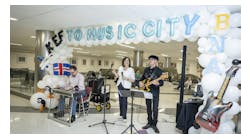We have all likely experienced the resonating sound of an airplane flying overhead, and of course, these instances affect those living in close proximity to airports the most. While there has been significant advancement in noise reduction technology over the years, even the most sophisticated technology can only do so much to alleviate the effects of airport noise on surrounding communities. As a result, airports around the globe are considering and implementing “Fly Quiet” Programs (FQP) to encourage operators to fly as quietly as possible.
Monitor, Analyze, Engage, Recognize
The primary purpose of an FQP is to encourage individual aircraft operators, pilots, and air traffic controllers to use noise abatement flight procedures, preferential runways, quieter aircraft, and other measures that minimize aircraft noise exposure to surrounding communities. Over the past decade, we have seen these programs put in place at major airports like Los Angeles International Airport, San Diego International Airport, and Seattle-Tacoma International Airport, as well as at smaller regional airports like Jackson Hole Airport and Aspen-Pitkin County Airport.
On August 17, 2022, John Wayne Airport (JWA) announced the launch of its “Fly Friendly Program”. JWA is already well known for its stringent access and noise regulatory structure through its landmark 1985 Settlement Agreement, Phase 2 Commercial Airline Access Plan and Regulation, and General Aviation Noise Ordinance. The Fly Friendly Program was specifically designed to minimize noise from General Aviation (GA) or private use jet aircraft to the airport’s surrounding communities. GA operators will receive points based on: (1) producing the least amount of measurable noise per year, (2) avoiding nighttime and early-morning operations, when possible, (3) engaging pilots in noise abatement education, distributing program materials, and/or attending community meetings, and (4) contributing toward ecological restoration and habitat enhancement projects.
“Fly Friendly is an education and outreach program designed to minimize noise and environmental impacts from general aviation jet aircraft. JWA will celebrate operators demonstrating the highest level of commitment to this program through an annual awards initiative,” said Charlene Reynolds, JWA’s Airport Director.
The Naples Airport Authority (NAA) is currently undertaking an update to its Title 14 Code of Federal Regulations (CFR) Part 150 Airport Noise Compatibility Planning Study. As part of the Noise Compatibility Program (NCP), Environmental Science Associates (ESA) is working with NAA to further enhance its Naples Airport (APF) “Fly Safe Fly Quiet Program,” which encourages pilots and passengers to observe the voluntary quiet hours to reduce aircraft noise in the Naples community.
“Naples is a very noise sensitive community. As a responsible member of the community, the NAA has developed a number of new and innovative ways to connect with pilots, passengers and the community, including ‘Plane Talk’ community open houses, adding curfew acknowledgement language in leases and badge applications, and offering AVTRIP points for delaying departures until after the curfew ends.” said Chris Rozansky, Executive Director at APF. He added, “Along with operating a safe and efficient airport, our role as an advocate for our community is always top of mind and our Fly Safe Fly Quiet Program is constantly updated to reflect industry leading ways to promote curfew compliance and noise abatement procedures.”
While these programs are completely voluntary and customized to each specific airport, the basic framework for an FQP involves monitoring, collecting, and analyzing comprehensive aircraft operational and noise data. Noise-related data is shared with operators, who are then scored and recognized on a regular and transparent basis for their efforts to reduce community noise exposure.
While scoring methodology and criteria will vary from program to program, elements of a program typically include the following performance metrics:
- Quietest/Loudest Arrivals/Departures - Based on measured noise levels from monitors in residential communities.
- Fleet – Based on noise levels of aircraft operating at the individual airport, as certified by the FAA after manufacture.
- Procedures – Based on operators’ adherence to published flight procedures.
- Preferential Runway Use – Based on operational runway use data, generally during nighttime and early morning hours.
- Engine Run Ups – Based on compliance with maintenance engine run-up restrictions, generally in effect during nighttime and early morning hours.
Getting Started
While also voluntary, airport sponsors can recommend the development of an FQP as part of undertaking a Title 14 CFR Part 150 Airport Noise Compatibility Planning Study. Defining a five-year vision of compatibility between an airport and the land use in surrounding communities, a Part 150 study establishes guidelines for a noise program that:
● Measures current and future aircraft noise levels and their associated effects on the surrounding communities.
● Outlines actions that will reduce or minimize aircraft noise over sensitive areas.
● Establishes land use guidelines to address compatibility between the airport and its surrounding communities.
● Identifies areas where aircraft noise is present and encourages land uses that are compatible.
Program management measures, such as the development of an FQP, that are approved by the Federal Aviation Administration (FAA) as part of a Part 150 study may be considered eligible for federal Airport Improvement Program (AIP) funding. This route can be beneficial for an airport sponsor by providing a cost-effective mechanism for enhanced community engagement, stakeholder outreach, and data/report automation.
Even without a Part 150 study or federal AIP funding, it is possible and highly beneficial for an airport sponsor to develop and implement an FQP on its own. It is recommended that airport sponsors determine the appropriate level of community and stakeholder engagement that they want to undertake during FQP development, as these factors greatly determine time and cost. Additionally, airport sponsors need to consider the degree of automation they want when it comes to collecting and analyzing noise-related data; more automation means more up-front costs, but less cost in the long-run due to less staff time required to process and analyze the data.
Benefits
There are several benefits of implementing an FQP. These programs provide a dynamic venue for compliance with noise abatement initiatives by publicizing and praising active participation (as opposed to a system that admonishes violations). FQPs also foster a stronger sense of partnership with surrounding communities by engaging all stakeholders to maximize effectiveness. Making this information available to a broader audience serves both as a motivational tool for the operators and an informational tool for the community. Positive reinforcement and publicity have proven to be strong incentives for increasing operator performance and program success.
Airport sponsors who have recently developed and implemented an FQP have experienced great success in increasing stakeholder engagement and encouraging noise reduction efforts from operators trying to improve their score and make their best effort to operate as quietly as possible. Successful FQPs typically see an increase in operators:
· Establishing pilot education programs
· Attending and participating in community meetings/forums
· Engaging other stakeholders, such as the FAA
· Retrofitting older aircraft with noise reduction technology
Justin Cook is a Senior Principal Aviation Specialist at Environmental Science Associates (ESA). He partners with airport operators to tackle complex issues affecting the development, operation, and resiliency of their facilities, including noise management and can be reached at [email protected].




